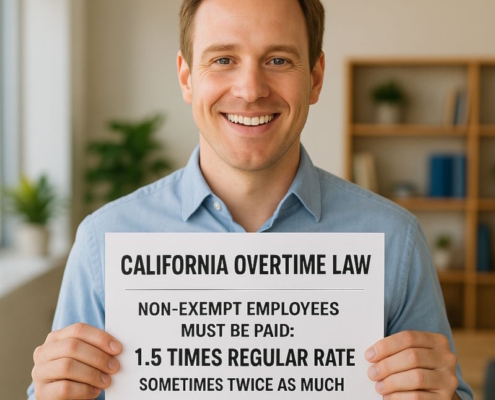How do you respond to a PAGA Notice?
PAGA requires that new claim notices, responses, and specific court documents be filed with the Labor and Workforce Development Agency (LWDA). To minimize the settlement amount you pay, there are six things you must do after receiving a PAGA notice letter.
Author: Douglas Wade, Attorney
Email | Call (800) 484-4610
The Labor Code Private Attorneys General Act (PAGA) authorizes aggrieved employees to file PAGA lawsuits to recover civil penalties on behalf of themselves, other employees, and the State of California for Labor Code violations. When you receive a PAGA notice letter, you should immediately do the following:
Step 1: Contact a PAGA Claim Defense Attorney
Upon receiving a PAGA notice, hire an attorney that has experience handling PAGA lawsuits. Do not “bet the farm” on a PAGA claim by hiring an attorney with experience defending PAGA claims. Our attorneys have at least 17 years of experience and defended hundreds of PAGA claims.
Step 2: Determine if Employees Wage Statements Comply with California Law
A substantial of PAGA notice alleged violation of pay-stub law. California Labor Code section 226 requires the following for wage statements (paystub):
An employer, semimonthly or at the time of each payment of wages, shall furnish to his or her employee, either as a detachable part of the check, draft, or voucher paying the employee’s wages, or separately if wages are paid by personal check or cash, an accurate itemized statement that shows the following:
- Gross wages earned.
- Total hours worked by the employee, except as provided in subdivision (j).
- The number of piece-rate units earned and any applicable piece rate if the employee is paid on a piece-rate basis,
- All deductions, provided that all deductions made on written orders of the employee may be aggregated and shown as one item.
- Net wages earned
- The inclusive dates of the period for which the employee is paid.
- The name of the employee and only the last four digits of his or her social security number or an employee identification number other than a social security number.
- The name and address of the legal entity that is the employer and, if the employer is a farm labor contractor, as defined in subdivision (b) of Section 1682, the name and address of the legal entity that secured the services of the employer.
- All applicable hourly rates in effect during the pay period and the corresponding number of hours worked at each hourly rate by the employee and, beginning July 1, 2013, if the employer is a temporary services employer as defined in Section 201.3, the rate of pay and the total hours worked for each temporary services assignment. The deductions made from payment of wages shall be recorded in ink or other indelible form, properly dated, showing the month, day, and year, and a copy of the statement and the record of the deductions shall be kept on file by the employer for at least three years at the place of employment or at a central location within the State of California. For purposes of this subdivision, “copy” includes a duplicate of the itemized statement provided to an employee or a computer-generated record that accurately shows all of the information required by this subdivision.
A violation of one or more of these requirements exposes an employer to PAGA claim in California.
Step 3: Immediately Make Wage Statement Comply with Labor code 226(a)
If the PAGA notice alleges wage statement violations, a wage statement violation under Labor Code 226(a) carries a penalty up to $4000 per employee. For a company with 100 employees, the penalty can be up to $400,000. Section 226(e)(1) states:
An employee suffering injury as a result of a knowing and intentional failure by an employer to comply with subdivision (a) is entitled to recover the greater of all actual damages or fifty dollars ($50) for the initial pay period in which a violation occurs and one hundred dollars ($100) per employee for each violation in a subsequent pay period, not to exceed an aggregate penalty of four thousand dollars ($4,000), and is entitled to an award of costs and reasonable attorney’s fees.
When served with a PAGA notice letter in California, update the wage statement immediately. By updating the wage statement to comply with Labor Code 226(a), the employer stops the bleeding i.e. future penalties. Updating the wage statement will minimize damages against a California PAGA claim.
Step 4: Cure Past Wage Statement Violations
PAGA authorizes an employer to “cure” specified violations of itemized wage statement requirements, within 33 days of the date of the PAGA notice from the aggrieved employee. (Labor Code sections 2699.3(c)(2)(A) and 2699.5.) A “cure,” in this context, signifies making the aggrieved employee whole and providing itemized wage statements for each pay period for the last three years. After served with a PAGA notice, employers should cure the wage statement violation.
The current 33-day period to cure period is only permitted for two types of PAGA claim wage statement violations:
- failure to include either the start and end date of the pay period pursuant, and
- failure to provide the name and address of the legal employing entity.
The current cure period of 33 days does not allow sufficient time for most employers to cure the wage statement violations after receiving a PAGA letter. A fully compliant wage statement must be provided to every employee for every pay period going back three years from the date the PAGA claim notice was filed with the LWDA. The PAGA claim will proceed but damages will minimize for the California PAGA claim.
Step 5: Review and Audit Payroll and Timekeeping Policy and Procedure
In many PAGA notice letters, the common mistakes employers made are:
- Employers do not reimburse employees for business costs and expenses.
- Employers do not reimburse employees for use of personal cell phone for business.
- Employers do not reimburse employees for mileage.
- Employers do not allow employees to leave premises for meal breaks.
- Employers rounding employee’s time worked.
- Employers do not pay overtime rate for overtime worked.
The above violations are the the bread of butter for PAGA lawyers who sends out PAGA notice letters.
Step 6: Analyze if the complaining employee an “aggrieved employee” which is another word for “standing.”
An employee must have standing to bring a PAGA claim in California. When you receive a PAGA notice letter, determine if the employee has standing. An employee has standing if the complainant is an “aggrieved employee” and satisfies two of the following:
- The employee was employed by the alleged violator; and
- The employee “personally suffered at least one Labor Code violation” on which he or she bases the PAGA claim.
PAGA allows “aggrieved employees” to pursue civil penalties against their employers on the state’s behalf, provided the employees comply with the notice procedures set forth in the statute. Cal. Lab. Code §§ 2699, 2699.3. An “aggrieved employee” is defined as “any person who was employed by the alleged violator and against whom one or more of the alleged violations was committed.” Id. § 2699(c).
PAGA claims in California essentially deputizes aggrieved employees to act as a private attorney general to enforce California’s workplace laws. The civil penalties a PAGA plaintiff may recover on the state’s behalf are distinct from the statutory damages that may be available to employees suing for individual violations of the Labor Code. Of the civil penalties recovered, 75% goes to the Labor and Workforce Development Agency and 25% goes to the aggrieved employees. Id. § 2699(i). In conclusion, when you receives a PAGA notice, please contact our PAGA defense attorney for a free consultation.
Have a quick question? We answered nearly 2000 FAQs.
See all blogs: Business | Corporate | Employment
Most recent blogs:































